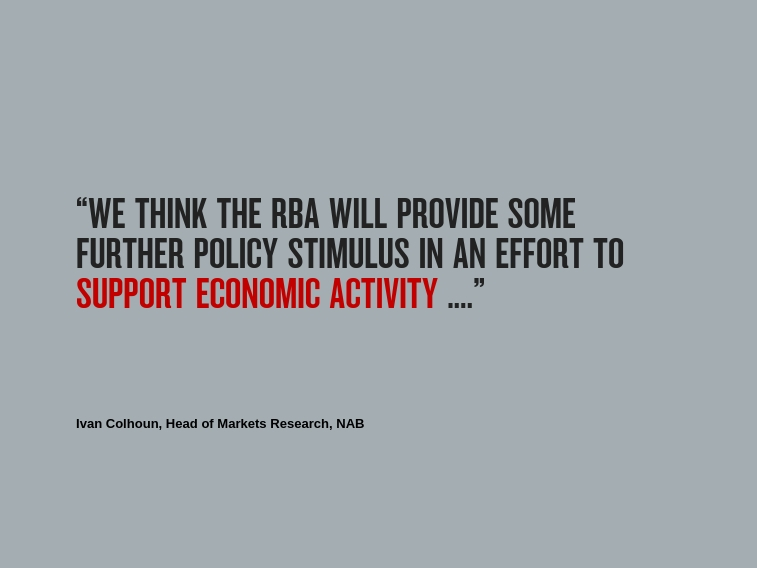We expect NAB’s Non-rural Commodity Price Index to fall by 4.9% in Q2


Insight
After 27 years of steady economic growth – a record unmatched by any other developed economy – some are asking whether Australia is overdue for a recession.

Economic expansions don’t die of old age – that’s the view of Janet Yellen, the former head of the U.S. central bank, the Federal Reserve. There needs to be a trigger – an external shock, a build-up of imbalances or a policy error – that turns growth into contraction.
At a panel discussion at the 5th Asset Allocation Australia summit earlier this month, sponsored by NAB, economists debated the increasingly live topic of whether a recession may be coming Australia’s way.
“Since the early 1990s, we’ve had an enviable quarter-century or more of growth without interruption,” said Ivan Colhoun, Head of Markets Research at NAB, who chaired the panel. “There’s a whole generation of workers who haven’t experienced an Australian recession.”
Indeed, expansions followed by downturns were the norm of the economic cycle before the 1990s, with a recession on average striking every seven or so years.
This enviable recent track record has been a combination of good luck (such as the surge in Chinese demand for iron ore that supported exports after the global financial crisis) and good management, particularly in the coordinated government and Reserve Bank response to the GFC and the beneficial stabilising effect of the floating Aussie dollar.
The panellists noted that large sections of the economy are relatively stable and don’t vary much over time. It’s the cyclical sectors such as business investment, export prices and housing that swing more sharply and can have a significant impact on economic output and Australian income.
“Downturns are rare events and the idea that they can be easily spotted and identified in advance – it’s like fool’s gold,” said Stephen Anthony, Chief Economist at Industry Super Australia.
The biggest risk currently, the panellists agreed, comes from the downturn in housing construction and the likely flow-on effects that will have on employment and consumer spending.
Economists have plenty of theories about what causes recessions and one of the least tangible causes and hardest to define is a change in confidence – from consumers, businesses and investors. Whether the recent downturn in the housing market will be a large enough blow to employment and confidence to trigger a domestic recession is an open question.
“I tend to look at the imbalances in the economy and the buffers that can offset those,” said Brian Redican, Chief Economist at NSW Treasury Corporation. “If we’ve been building 220,000 homes a year, a rate that’s well above the long-term average of 150,000 houses, then that suggests quite a bit of downside risk if housing construction goes back to the long-term trend.”
A related concern is the interaction with high levels of household debt, in part related to interest rates remaining at very low levels since the GFC.
At the same time that the economy faces a number of domestic risks, there are signs that China’s economy is also slowing.
Mr Redican said this is already having a dampening effect on Chinese investment in Australian real estate, and could lead to a slowdown in tourism or foreign student university enrolments as well – a huge source of export revenue, with education ranking as Australia’s third largest export.
On the flipside, there are a range of policy measures that could help to offset a downturn, such as tax cuts or further reductions in the Reserve Bank’s official interest rate.
NAB has changed its rates forecast to expect two RBA rate cuts this year, following weaker-than-expected H2 2018 GDP data and deteriorating business conditions reported in the NAB Business Surveys from December to February.
“With the RBA being forward-looking and monetary policy impacting with a lag, we think the RBA will provide some further policy stimulus in an effort to support economic activity and prevent any rise in the jobless rate,” Mr Colhoun said.
But with the cash rate currently sitting at 1.5 per cent, the RBA has less ability to cut rates sharply now to stimulate growth than it has had at any time in the past.
The panel heard that the Reserve Bank may eventually have to consider non-traditional policy options such as those that have been adopted by U.S. and European central banks, though this prospect seemed some way off.
“The traditional options on monetary policy are limited,” said Katie Dean, Senior Manager, Fixed Income Strategy at AustralianSuper.
“As for quantitative easing, the RBA may be actively considering that and may have a plan of attack, should it come to that,” she said, referring to a policy of buying up government bonds to increase the supply of money and lower long-term market interest rates.
Other options would likely include substantial fiscal stimulus including through further large-scale infrastructure projects, which would not only create jobs but could help boost productivity in the longer term.
Mr Anthony said that super funds have a strong appetite for infrastructure assets and could quickly move to help finance investment in such major projects.
“You would want to have some large infrastructure projects planned and ready to roll out, ticking off the list of Infrastructure Australia’s projects, in case the storm comes.”
Speak to a specialist
© National Australia Bank Limited. ABN 12 004 044 937 AFSL and Australian Credit Licence 230686.